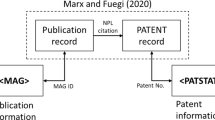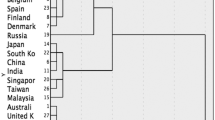Abstract
We investigate the relationship between the science intensity of technology domains and country's performance within these domains. The number of references in patents to scientific articles is considered as an approximation of the science intensity of a technology domain whereas a country's technological performance is measured in terms of its technological productivity (i.e. number of patents per capita). We use USPTO patent-data for eight European countries in ten technological domains. A variance analysis (ANOVA) is applied. Country as an independent variable does not explain a significant portion of the observed variance in science intensity (p=0.25). Technology domain, however, explains a significant portion of the observed variance (p<0.001). Moreover, in science intensive fields we find a positive relation between the science linkage intensity of these fields and the technological productivity of the respective countries involved. These findings seem to suggest the relevancy of designing innovation policies, aimed at fostering interaction between knowledge generating actors and technology producers, in a field specific manner.
Similar content being viewed by others
References
Andersen, B. (2001), Technological Change and the Evolution of Corporate Innovation. Edward Elgar Publishing.
Bijker, W. (1995), Of Bicycles, Bakelites and Bulbs-Towards a theory of socio-technical change. MIT Press.
Collins, P., Wyatt, S. (1988), Citations in patents to the basic research literature. Research Policy, 17: 65–74.
Cohen, W. M., Levinthal, D. A. (1990), Absorptive capacity: A new perspective on learning and innovation. Administrative Science Quarterly, 35: 128–152.
De Solla Price, D. (1965), Is technology historically independent of Science? A study in statistical historiography. Journal of Technology and Culture, 6: 553–568.
Etzkowitz, H., Leydesdorff, L. (1997), Introduction to special issue on science policy dimensions of the Triple Helix of university-industry-government relations. Science and Public Policy, 24: 2–5.
Etzkowitz, H., Leydesdorff, L. (1998), The endless transition: A ‘Triple Helix’ of university-industry-government relations. Minerva, 36: 203–208.
Etzkowitz, H., Leydesdorff, L. (2000), The dynamics of innovation: from National Systems and 'Mode 2' to a Triple Helix of university-industry-government relations. Research Policy, 29: 109–123.
Grupp, H., Schmoch, U. (1992), Perception of scientification of innovation as measured by referencing between patents and papers. In: H. GRUPP (Ed.) Dynamics of Science-Based Innovations, Springer Publishers, Berlin/Heidelberg, pp.73–128.
Leydesdorff, L., Etzkowitz, H. (1996), Emergence of a Triple Helix of university-industry-government relations. Science and Public Policy, 23 (5): 279–286.
Leydesdorff, L., Etzkowitz, H. (1998), Triple Helix of innovation: introduction. Science and Public Policy, 25 (6): 358–364.
Mccartney, S. (1999), Eniac, the Triumphs and Tragedies of the Worlds First Computer. Berkley Books, New York.
Mcculloch, R. (1980), International indicators of science and technology-how does the US compare? Scientometrics, 2: 355–367.
Meyer, M. (2000a), Patent citations in a novel field of technology. What can they tell about interactions between emerging communities of science and technology. Scientometrics, 48: 151–178.
Meyer, M. (2000b), Does science push technology? Patents citing scientific literature. Research Policy, 29: 409–434.
Meyer-Krahmer, F., Schmoch, U. (1998), Science-based technologies: university-industry interactions in four fields. Research Policy, 27: 835–851.
Mowery, D. C., Simcoe, T. (2002), Is the internet a US invention?-an economic and technological history of computer networking. Research Policy, 31: 1369–1389.
Narin, F., Noma, E. (1985), Is technology becoming science? Scientometrics, 7: 369–381.
Narin, F., Olivastro, D. (1992), Status report: Linkage between technology and science. Research Policy, 21: 237–249.
Narin, F., Olivastro, D. (1998), Linkage between patents and papers: an interim EPO/US comparison. Scientometrics, 41: 51–59.
Narin, F., Hamilton, K., Olivastro, D. (1997), The increasing linkage between US technology and public science. Research Policy, 26: 317–330.
OECD (1994), The Measurement of Scientific and Technological Activities: Using Patent Data as Science and Technology Indicators. Patent Manual 1994, Paris.
Porter, M. (1995), The Competitive Advantage of Nations. New York, The Free Press.
Rip, A. (1992), Science and technology as dancing partners. In: Kroes, A., Bakker, M. (Eds.) Technological Development and Science in the Industrial Age. Kluwer Publications.
Schmoch, U. (1993), Tracing the knowledge transfer from science to technology as reflected in patent indicators. Scientometrics, 26: 193–211.
Schmoch, U. (1997), Indicators and the relations between Science and Technology. Scientometrics, 38: 103–116.
Schön, D. (1963), Invention and the Evolution of Ideas-The Displacement of Concepts. Tavistock Publications.
Soete, L.G., Wyatt, S. M. E. (1983), The Use of Foreign Patenting as an Internationally Comparable Science and Technology Output Indicator. Scientometrics, 5: 31–54.
Van Viaenen, B., Moed, H., Van Raan, A. (1990), An exploration of the science base of recent technology. Research Policy, 19: 61–81.
Verbeek, A., Debackere, K., Luwel, M., Andries, P., Zimmermann, E., Deleus, F. (2002a), Linking science to technology: Using bibliographic references in patents to build linkage schemes. Scientometrics, 54: 399–420.
Verbeek, A., Callaert, J., Andries, P., Debackere, K., Luwel, M., Veugelers, R. (2002b), Science and Technology Interplay-A Modelling Approach on a Regional Level. Final Report to the EC DG Research, Brussels (also forthcoming in the EC Indicators report 2003).
Author information
Authors and Affiliations
Corresponding author
Rights and permissions
About this article
Cite this article
Looy, B.V., Zimmermann, E., Veugelers, R. et al. Do science-technology interactions pay off when developing technology?. Scientometrics 57, 355–367 (2003). https://doi.org/10.1023/A:1025052617678
Issue Date:
DOI: https://doi.org/10.1023/A:1025052617678




